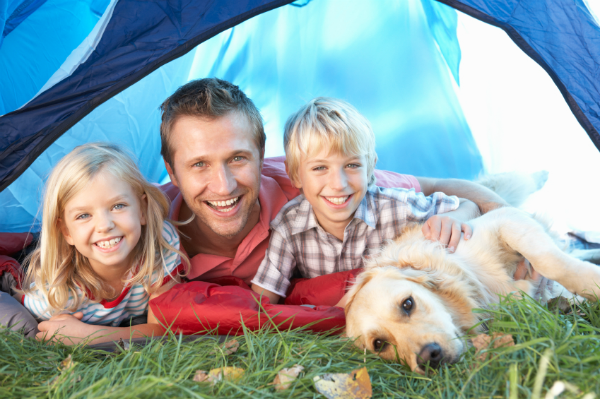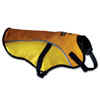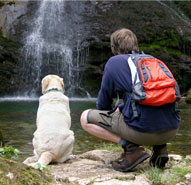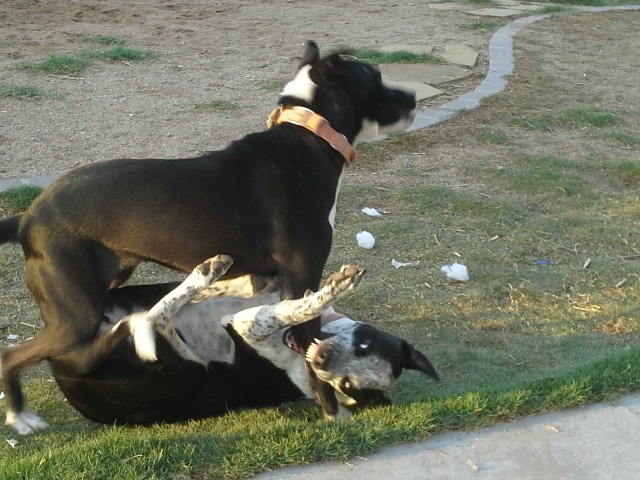Camping with Pets: Top 10 Threats to Dogs
Share

 Summer is here in most areas of the country, and that means a lot of people will be headed to the mountains with their pets to explore the great outdoors. There’s not a dog alive who doesn’t enjoy a weekend in the woods and it can be the most gratifying thing you ever do with your pets. But we want you to be prepared before you pack up your pup and hit the trails.
Summer is here in most areas of the country, and that means a lot of people will be headed to the mountains with their pets to explore the great outdoors. There’s not a dog alive who doesn’t enjoy a weekend in the woods and it can be the most gratifying thing you ever do with your pets. But we want you to be prepared before you pack up your pup and hit the trails.
First and foremost is the leash law. Pets are allowed in nearly all national forests, however there are stiff penalties in place devoted to ensuring your pets remain on leash. If you’re not sure what the laws are in your area of the country, visit PetFriendlyTravel for an updated list by state and county. Observe all forest and county laws requiring leashed pets. There are national Forest Service regulations which state that pets in all forest campgrounds must be leashed, specifically on a leash that is 6 feet or shorter. Responsible pet ownership requires that all leash laws be obeyed, for the safety of the public, wildlife and other pets.
Beyond that, here is a look at our picks for the Top 10 Camping Threats to Your Pets:
[heading style=”1″ color=”#996633″ style_color=”#996633″]1. Other Dogs[/heading]
In any given year, there are dozens of reports filed throughout the nation about dogs that were attacked while camping with owners. There is something almost primal about returning to nature and just as it sets off a new set of instincts in people, it does the same for our pets. The person or pets you take camping in the wilderness may become different than the person or pets you know and love at home.
Each year, we hear stories of dogs that were killed by other dogs while camping. Keep a close eye on your pets while camping and keep them away from other people’s pets.
Furthermore, it is often a crime to allow your dog to met other unleashed animals. In Phoenix, Arizona – a civil Dog at Large charge can be issued if the dog is wearing a collar or harness with a valid license and is unconfined. This could result in a fine ranging from $0 to $250. A criminal Dog at Large charge is issued if the dog is not wearing a harness and license while unconfined, and can result in a fine up to $2,500, probation up to 3 years, and jail up to 180 days. Check your own areas to learn what the fines are in your county.
[heading style=”1″ color=”#996633″ style_color=”#996633″]2. Native Wildlife[/heading]
As animal lovers, it is our responsibility to respect wildlife and to make sure our pets are doing the same. It’s also illegal to let your dogs chase wildlife. So, whether it’s a fascinating squirrel, a slow-moving porcupine, a quick-on-the-draw skunk, or a wily coyote… if its around your camp or in the woods, your dogs are likely to be the first to find them.
The problem can really escalate if another predator had their eye on that little rabbit. Chances are good that larger predators such as a mountain lions or bears lurking nearby will find your dog. Don’t encourage your dogs to chase wildlife and you’ll be less likely to experience a trip to the vet or to pay a fine when the forest service finds out about it (it’s illegal to hunt with or allow your dogs to pursue wild game without a hunting license in most states).
[heading style=”1″ color=”#996633″ style_color=”#996633″]3. Hunters, Weapons Enthusiasts, and People in General[/heading]
 When camping, be sure your pet is wearing a reflective collar and/or a reflective vest of some kind. Whether you have a small dog or big dog, a hunter could take a shot at your pet either out of misidentifying your small dog as a rabbit or squirrel or your big dog as a coyote.
When camping, be sure your pet is wearing a reflective collar and/or a reflective vest of some kind. Whether you have a small dog or big dog, a hunter could take a shot at your pet either out of misidentifying your small dog as a rabbit or squirrel or your big dog as a coyote.
The responsible hunters will never shoot before completely identifying the animal; but unfortunately, responsible hunters are few and far between. Protect your pets and keep an eye out for the irresponsible use of firearms. If you notice anyone using a firearm irresponsibly, report them to your forest service.
At the same time, beware of the forest service. If they deem your pet a threat, they are within their right to shoot your dog. That means your dog must be VISIBLY under control at ALL times (namely, on a leash).
Be sure you know basic first aid for pets when camping, and how best to treat a minor wound. Always bring along a first aid kit for your pets as they’re needs are different from ours. Here are a few examples of kits you can purchase or ones you can make on your own
[heading style=”1″ color=”#996633″ style_color=”#996633″]4. Parasites & Insects & Reptiles[/heading]
 Insects like black widows, brown recluse spiders, and scorpions are easily found in the wild. Be sure you understand the threats that live in your area and become aware of the symptoms you’ll see in you and your pets should you get bitten.
Insects like black widows, brown recluse spiders, and scorpions are easily found in the wild. Be sure you understand the threats that live in your area and become aware of the symptoms you’ll see in you and your pets should you get bitten.
Mosquitoes can carry west Nile virus and heart-worm. Be sure that your pet is on heart-worm prevention to protect from internal parasites, and always carry an all-natural pest repellent that is safe for your pets, such as Flea Dust from DERMagic or Buzz Guard from EarthHeart. Here are other ways you can help your pets naturally repel fleas, ticks and mosquitoes while camping.
Your pets should be checked for ticks each day. Ticks are very common throughout every state in the US and can cause Lyme disease. It’s important to keep an eye on your pets for any sign they have been bitten. Identify what is an emergency and what should be treated conservatively so your camping trip doesn’t end in tragedy.
Your dog has the potential to be exposed to a host of diseases from internal parasites. Throughout the Western half of the United States, the Hantavirus is still alive and well. Plague, which most believe was eradicated during the Middle Ages, is still prevalent in the Four Corners area (UT, CO, AZ, NM) and throughout the Western US. Both are diseases that can be transferred through the exposure to or consumption of waste from mice or rats.
 Rattlesnakes and copperheads are present throughout the USA. This is why snake training your dog is so very important. Not only could such training save your pets life, it could save the life of a family member or friend. We heard one case in which a dog alerted an owner to a snake that lurked under the chair he was about to sit in – all because he had the forethought to snake train his dog.
Rattlesnakes and copperheads are present throughout the USA. This is why snake training your dog is so very important. Not only could such training save your pets life, it could save the life of a family member or friend. We heard one case in which a dog alerted an owner to a snake that lurked under the chair he was about to sit in – all because he had the forethought to snake train his dog.
Be aware of the threats in your region and discuss options with your veterinarian prior to a bite becoming an emergency.
[heading style=”1″ color=”#996633″ style_color=”#996633″]5. Eating Unknown Items: Mushrooms, Plants & Discarded Food[/heading]
There are many things that pets can get into in the wild, not the least of which include wild mushrooms, poisonous plants, and the remains of animals or fish. Be very aware of what your pet eats and be on the lookout for signs of poisoning.
Visit this link from the ASPCA for a list of plants that can be toxic to your pets and be sure to check the area around the campground for any discarded food when you arrive.
[heading style=”1″ color=”#996633″ style_color=”#996633″]6. Diseases: Rabies, Parvo, and Distemper[/heading]
 Dogs can get sick from parasites, viruses, bacteria, protozoa, and fungus – just as we can. And if you catch things early, chances are excellent you can begin treatment early.
Dogs can get sick from parasites, viruses, bacteria, protozoa, and fungus – just as we can. And if you catch things early, chances are excellent you can begin treatment early.
Here’s the thing: just because you are a responsible pet owner does not mean other pet owners are. Most viruses such as distemper and parvo, can live in the ground for years, and can even sweep by in the wind. This is why its important to make sure your pets are up-to-date on vaccinations and watched carefully for any illnesses upon your return. If your pet does contract something while camping, be sure to report the area to authorities.
If you live in the Southwest, namely Arizona, you’ll also need to keep an eye out for symptoms of Valley Fever. While there isn’t much you can do to prevent your pets or yourself from this ailment, your pet will need to be treated if he begins exhibiting signs of the illness.
Rabies is another common transmissible disease and a real concern in the wilderness. More than 90% of all animal cases reported annually to CDC now occur in wildlife. The principal hosts for rabies includes bats and other carnivores (woodchucks, bobcats, mountain lions, raccoons, etc.) The CDC has an extensive page on Rabies and its transmission. Make sure your pets are vaccinated and you can help stop any type of zombie apocalypse.
[heading style=”1″ color=”#996633″ style_color=”#996633″]7. Predators In Camp[/heading]
 Coyotes, wolves, bobcats, bears and mountain lions are all alive and well – and when you camp, you enter their domain. Be respectful. Train your dogs to be respectful. Never allow them to chase or corner a wild animal, and teach them how to alert rather than attack if a wild animal enters your camp.
Coyotes, wolves, bobcats, bears and mountain lions are all alive and well – and when you camp, you enter their domain. Be respectful. Train your dogs to be respectful. Never allow them to chase or corner a wild animal, and teach them how to alert rather than attack if a wild animal enters your camp.
Porcupines and skunks, both of which have the ability to seriously call a halt to your camping trip, can be resolved easily enough if you have the proper equipment. If you’re in a skunk heavy area, you may want to stash a bottle of Skunk-off Soaker into your camping gear. It’s a great way to disinfect your pet from a skunk attack, without all the hassle of carrying tomato juice only to have the smell return an hour later.
[heading style=”1″ color=”#996633″ style_color=”#996633″]8. Heat Stroke and Dehydration[/heading]
 Pets like to push their limits when they’re hiking and they may be too excited to realize that they are getting overheated. Remember that you are ultimately responsible for your pet drinking water.Carry plenty of water for you and them, and if you have a larger dog who is accustomed to a pack, you may want to invest in the Ruffwear Palisades Pack
Pets like to push their limits when they’re hiking and they may be too excited to realize that they are getting overheated. Remember that you are ultimately responsible for your pet drinking water.Carry plenty of water for you and them, and if you have a larger dog who is accustomed to a pack, you may want to invest in the Ruffwear Palisades Pack for extensive hiking. This pack contains water storage that enables your pet to carry their own refreshments.
Be sure you are aware of the signs of heat stroke in pets, and ways that you can help your pet beat the heat. CPR can mean the difference between life and death in your pets, so consider signing up for a short 4-hour course to learn the ins and outs of this simple procedure.
[heading style=”1″ color=”#996633″ style_color=”#996633″]9. Paw Injuries[/heading]
 From hard hiking to foxtails, your pets paws are the most likely to be injured during a camping trip. Foxtails are wild grasses in the barley and wheat family that seem to find their way into every campground. Unfortunately, once they lodge between your pets paws, they often require surgical removal. Other threats to your pets paws include new terrain and too much walking. Remember to check your pets paws often, at least three times per day, to ensure safe hiking.
From hard hiking to foxtails, your pets paws are the most likely to be injured during a camping trip. Foxtails are wild grasses in the barley and wheat family that seem to find their way into every campground. Unfortunately, once they lodge between your pets paws, they often require surgical removal. Other threats to your pets paws include new terrain and too much walking. Remember to check your pets paws often, at least three times per day, to ensure safe hiking.
Invest in a pair of boots for your dog so you can avoid costly medical bills upon your return. We like these heavy-duty Grip Trex Boots from Ruffwear or these All Weather boots from Muttluks but if your pet refuses to keep them on, you might want to try something like these Pawz Water-Proof Dog Boots
– they look like balloons, but I’ve yet to meet a dog who can’t keep them on (and they are waterproof)!
 [heading style=”1″ color=”#996633″ style_color=”#996633″]10. Getting Lost[/heading]
[heading style=”1″ color=”#996633″ style_color=”#996633″]10. Getting Lost[/heading]
Many animals enjoy hiking with their humans, but if you don’t have them on a leash (and these days, you should), you run the risk of a curious dog disappearing from the trail. Be sure you know where your dog is at all times.

Remember, not all GPS trackers work when you are out of cell phone range. Be sure you know the main components of your tracker and whether it is radio-centric or cell-phone centric. Here are two of our favorites:
- Tagg-GPS Tracker
: For cell-based, activity tracking
- RoamEO Pet Monitor System
: For camping in remote areas while only utilizing radio based traffic or international travel.
Have a great camping weekend and be safe out there in the wild with your pets!













